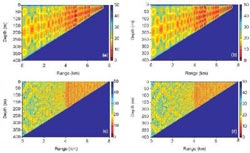An efficient method for solving sound propagation in range-dependent ocean waveguides was found

The source is located at a range of 4 km and a depth of 100 m by the: (a) analytical solution at 25 Hz; (b) present model at 25 Hz; (c) analytical solution at 100 Hz; (d) present model at 100 Hz. Credit: © Science China Press<br>
Professor LUO Wenyu and his group from the State Key Laboratory of Acoustics, Institute of Acoustics, Chinese Academy of Sciences, set out to tackle this problem. After several years of innovative research, they have developed an accurate, efficient, and numerically stable coupled normal mode method to solve the range-dependent propagation problem. Their work, entitled “A numerically stable coupled-mode formulation for acoustic propagation in range-dependent waveguides”, was published in SCIENCE CHINA Physics, Mechanics & Astronomy. 2012, Vol. 55(4).
Underwater sound propagation in range-dependent waveguides is critical to many studies and applications in the area of underwater acoustics. Neglect of waveguide range-dependence may lead to significant prediction errors. A number of approaches have been developed for solving this problem. Despite significant recent advances, problems such as intensive computation and instability remain unsolved. Therefore, the need for developing new approaches with better efficiency, stability, and accuracy is urgent.
In the method proposed by LUO et al., the direct global matrix (DGM) approach is applied. As is well-established, the primary advantage of the DGM approach is that it gives numerically stable solutions when there is evanescence across layers, and it does this without special numerical treatment. Therefore, the proposed method is unconditionally stable. Furthermore, by introducing appropriately normalized range solutions, the overflow problem inherent in certain existing models is eliminated. In addition, general source conditions were put forward, which significantly extends the applicability of the proposed model compared to existing models.
To validate a range-dependent model, we have the following possible methods: comparison with analytical solutions, checking energy conservation and reciprocity and inter-model comparison. The proposed method is validated by comparison with the analytical solution to an ideal wedge benchmark problem. Here, a range-dependent problem involving a wedge-shaped waveguide with pressure-release boundaries is analyzed. Since sound propagation towards the wedge apex will be completely backscattered due to perfectly reflecting boundaries, this test problem is an ideal benchmark for a full two-way solution to the wave equation. The comparison indicates that the proposed model is highly accurate and numerically stable (as shown in the Figure). Furthermore, this method provides high computational efficiency. The execution time for the proposed model is less than 10 % of that of the COUPLE model, which is a widely used coupled normal mode model. Note that although an ideal waveguide problem is used to validate the proposed method, the formulation presented also applies to realistic waveguides with penetrable bottoms and/or depth-variant sound speed profiles in water.
Implementation and promotion of this work will contribute significantly to the study of underwater sound propagation.
This research was partially supported by grants from the National Natural Science Foundation of China and the Knowledge Innovation Program of Chinese Academy of Sciences. The proposed method proves to be accurate, efficient, and numerically stable. The researchers suggest their work be extended and applied to the study of three-dimensional effects, for instance, the horizontal refraction that is present in complex environments. This will have significant impact on the study of three-dimensional underwater sound propagation.
See the article: Luo W Y, Yang C M, Qin J X, et al. A numerically stable coupled-mode formulation for acoustic propagation in range-dependent waveguides. SCIENCE CHINA Physics, Mechanics & Astronomy, 2012, 55(4): 572-588
Media Contact
All latest news from the category: Physics and Astronomy
This area deals with the fundamental laws and building blocks of nature and how they interact, the properties and the behavior of matter, and research into space and time and their structures.
innovations-report provides in-depth reports and articles on subjects such as astrophysics, laser technologies, nuclear, quantum, particle and solid-state physics, nanotechnologies, planetary research and findings (Mars, Venus) and developments related to the Hubble Telescope.
Newest articles

Superradiant atoms could push the boundaries of how precisely time can be measured
Superradiant atoms can help us measure time more precisely than ever. In a new study, researchers from the University of Copenhagen present a new method for measuring the time interval,…

Ion thermoelectric conversion devices for near room temperature
The electrode sheet of the thermoelectric device consists of ionic hydrogel, which is sandwiched between the electrodes to form, and the Prussian blue on the electrode undergoes a redox reaction…

Zap Energy achieves 37-million-degree temperatures in a compact device
New publication reports record electron temperatures for a small-scale, sheared-flow-stabilized Z-pinch fusion device. In the nine decades since humans first produced fusion reactions, only a few fusion technologies have demonstrated…





















